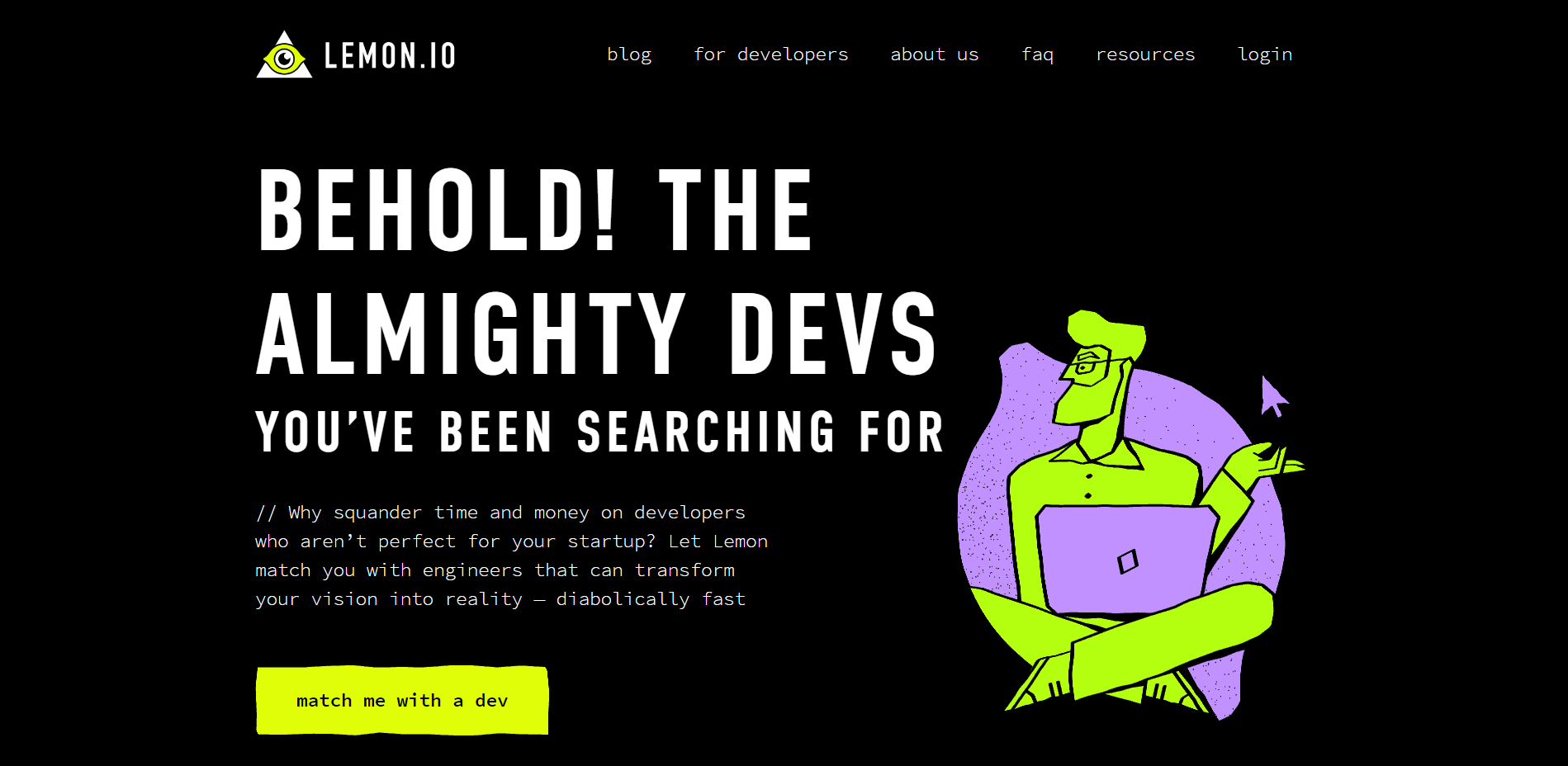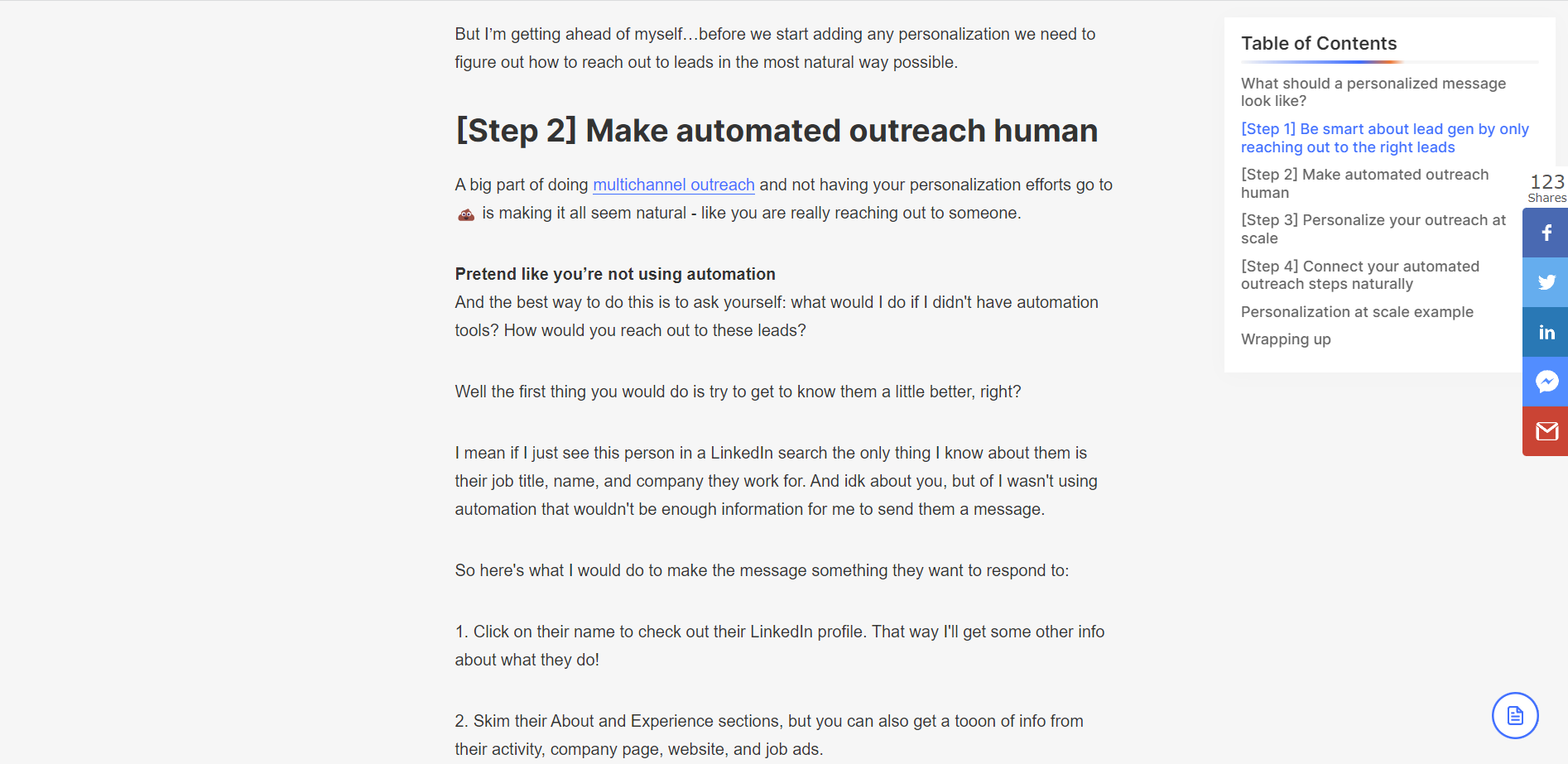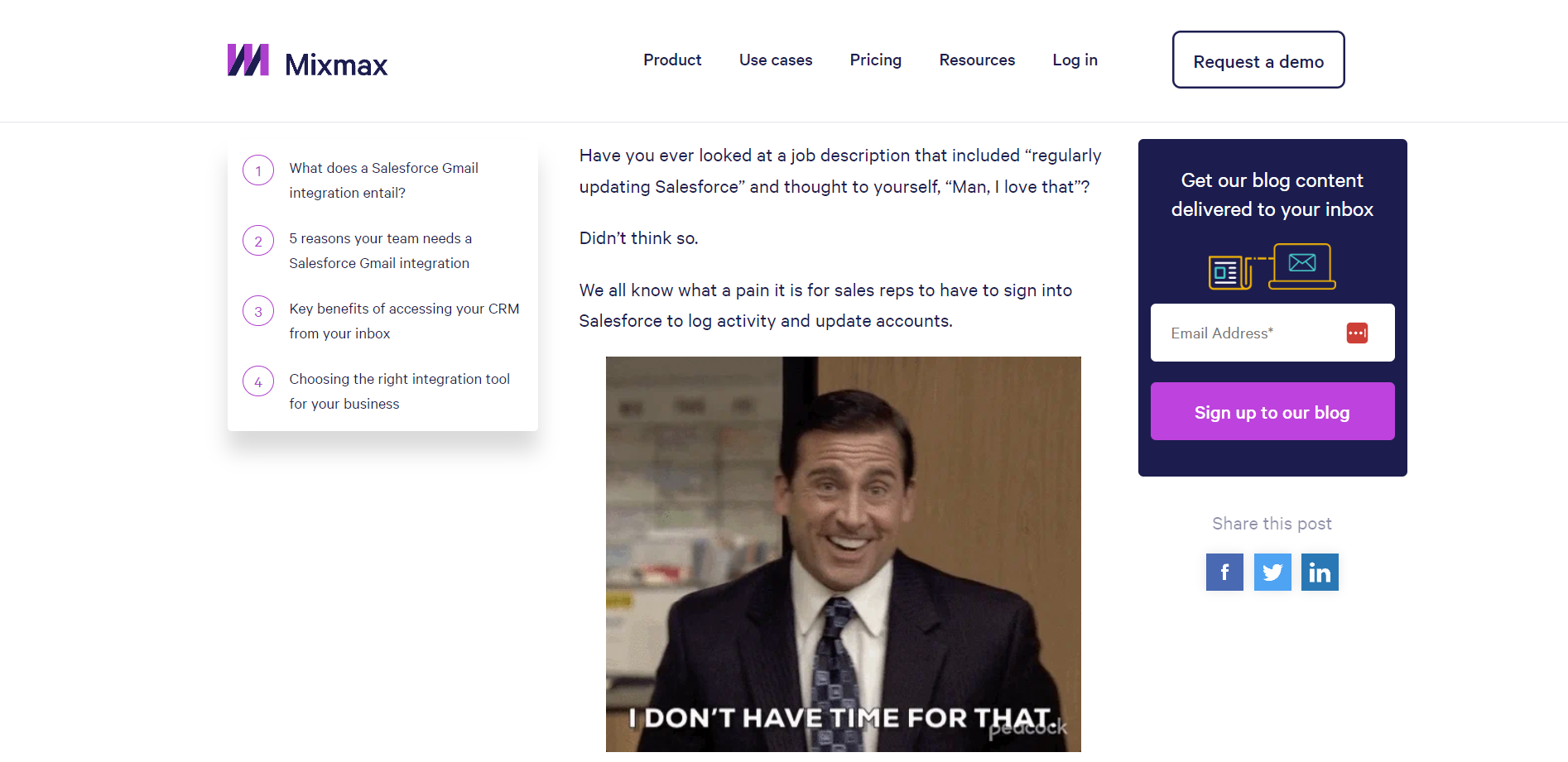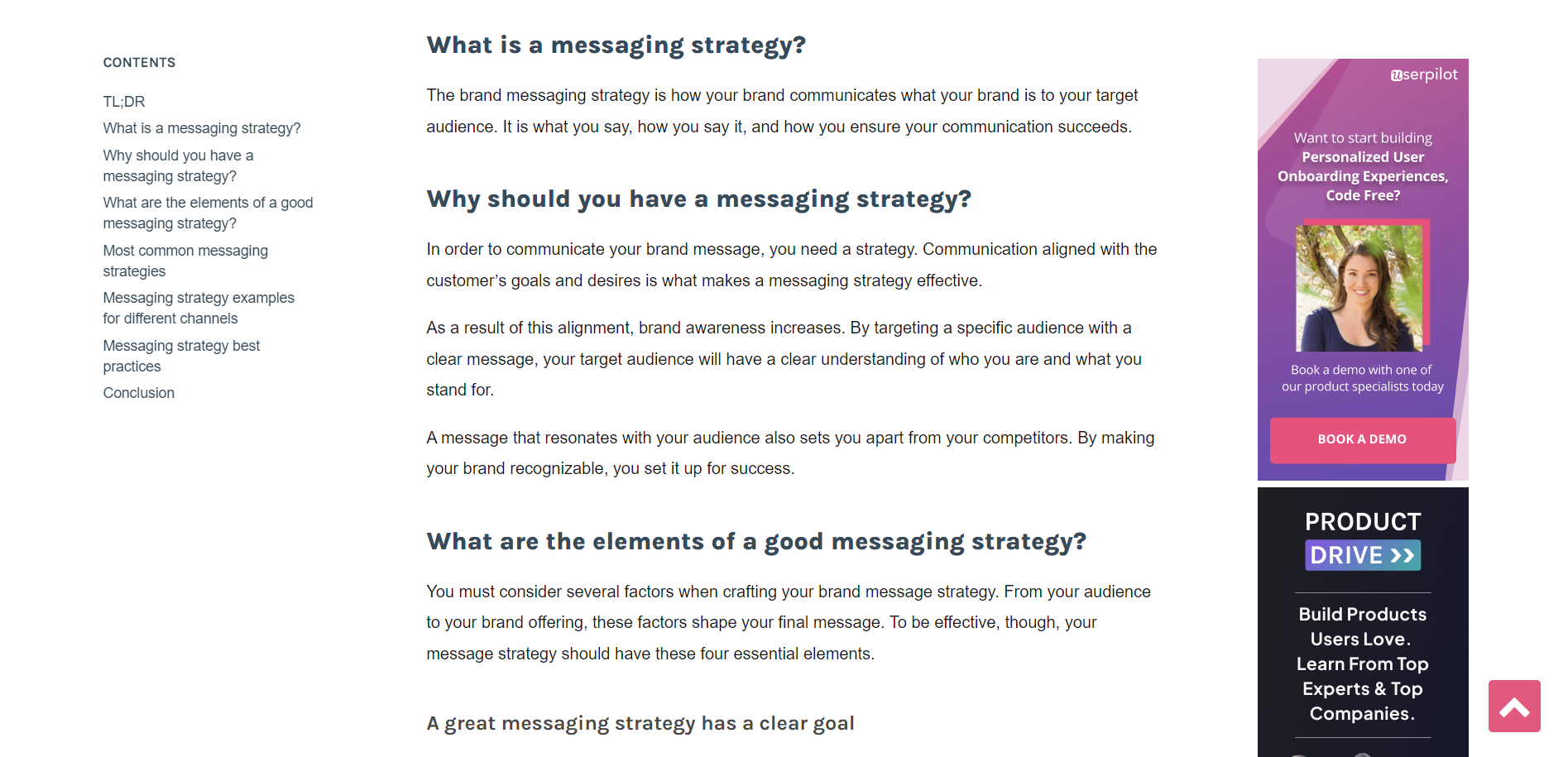Since the dawn of time, B2B brand voice has been the archetypical buttoned-up type: stern, serious, intelligent. Think Don Draper.
There isn’t anything wrong with this, per se. But when the whole B2B world began to look and sound the same, it quickly garnered its infamous pseudonym “Boring to Boring.”
Luckily, as more and more businesses realize it’s okay to venture outside this realm and still be taken seriously, they began to rebrand their verbal identities. But how exactly do you step outside of your comfort zone and create something memorable? I’m here to help with just that.
How to get started
Like any good project, you’ll want to jump in with a few brainstorming ideas and research questions to spark creativity and rationale before you simply pick a voice out of a hat or worse—copy someone else’s!
Start with your mission and values
Any solid brand identity will include your brand’s mission and core values. Just like Nike’s motivational and feel-good brand voice stems from its mission “To bring inspiration and innovation to every athlete in the world,” your brand voice, too, can be created from your deeper identity.
Simply ask yourself, “how can we live out our values through words, phrases, and content?”
You can start with “I believe” sentences to get ideas flowing in the right order. Let’s take Lemon.io, for example. This freelance platform that connects developers with start-ups has a wickedly unique voice.

Lemon.io weren’t afraid to go big with a brand identity unique to them. Source: Lemon.io
Their starting point could have begun with the phrase: “We believe building startups is all about the joy of creating something that did not exist before.”
This could have led them to decide upon such brand voice pillars as: medieval (a brand voice in the space that definitely did not exist before), honest and approachable (which resonates with start-ups) and uplifting (which connects to the joy they wish to bring).
Audit your best-performing content
Now, it’s very plausible your B2B company is already up and running with a solidified brand identity—but brand voice has got you feeling stuck. That’s because visual identity always makes its way into a brand deck, while verbal identity comes a bit later. Do not fret!
In this case, simply head to your best-performing content. There, you can find insights into what your audience loves to receive from you and start to unpack how your personality shines through those pieces.
Do they enjoy thought leadership articles packed with controversial ideas that spark conversations? You may be the authoritative, data-driven Warren Buffet of your market.
Do they enjoy your raw, personal stories of your journey from rags to riches? You may be the warm parental figure guiding them toward a better future.
Do they love your tongue-in-cheek humor that lightens the mood on an otherwise sensitive or stuffy topic? You may be the approachable, knowledgeable friend they turn to for answers.
Using voice analytic tools and a proprietary process, I believe everyone falls into one of nine different personality types. Get in touch with me to find out yours and bypass the research!
Learn to speak the way your customer speaks
When crafting your verbal identity, it’s important that it doesn’t just align with your values and knowledge (so that writing comes naturally to you) but that it also aligns with how your ideal customers speak (so that it resonates with the conversations going on in their heads).
So how do you find that out?
Flying Cat Marketing editor Kate Williams recommends “looking at review sites, forums, and customer interviews conducted to get an idea of how the client’s customers speak about certain topics—and their level of knowledge.”
For example, consider the following:
- Do they speak in full sentences or in choppy thoughts?
- What is their vocabulary level? Do they sound like an entry-level learner or experienced professional?
- How do they refer to your product or service? What kind of slang do they use?
- What references to pop culture or current events do they make?
- What do they dislike about the current market? How do they describe these pain points?
A note on jargon:
Jargon certainly gets a bad rap; however, it’s not always bad. A reader of an SEO blog with marketing and basic SEO knowledge will still understand “jargon” terms such as backlinks, anchor text, and organic search.
When creating a style guide for FCM clients, Kate adds “[Sometimes] we might be targeting readers with less industry knowledge, so we need to keep the language more jargon-free and down-to-earth.”
Do a competitor audit to stand out from the crowd
From Liquid Death to Old Spice to Wendy’s Twitter account, there are always examples of brands using voice to cut through the noise.

Wendy’s practically reinvented themselves with their meme-happy Twitter account. Source: Twitter
Now, there’s no need to hire a Gen Z intern to cause a ruckus on the internet, but if everyone around you leads with authority and gravitas, for example, perhaps you want to lead with likeability and a sprinkle of sunshine.
Document it in a style guide
Research shows that brands with consistent presentation can increase revenue by 33%. So it’s important not just to have a rough overview of your brand voice, but to spend time documenting the verbal identity in a style guide.
“Giving writers a really clear, granular sense of what great writing looks like for that particular company, and what’s expected from their content, saves so much editing time,” says FCM editor, Gill Moore. “It’s really important to include lots and lots of examples of what this looks like in context, both for tone and specific stylistic decisions.”
Here are some examples of what can go inside.
A personality to represent your voice
Just like someone you met at a party is easy to describe, so is a “personality” figure you create to represent the overall feel of the brand voice. When you’re an entrepreneur or a start-up, it’s common to base this on yourself or the CEO of the company.
In the example of FCM, the brand is closely based on CEO Maeva Cifuentes’ personality. Kate Williams tells us that’s defined as “smart, cool, capable… well-informed, [and] with a can-do attitude and high standards that they hold themselves to as much as anyone else.”
3-5 different voice pillars
Voice pillars are adjectives used to describe your voice. You can use the Nielsen Norman Group’s four dimensions of tone of voice to map to start. These are:
- Funny vs. serious
- Formal vs. casual
- Respectful vs. irreverent
- Enthusiastic vs. matter-of-fact
Use this to decide where your brand sits on the scale.
Alternatively, try the “this but not that” method. For example:
- Hopeful but realistic
- Educated but not pedantic
- Supportive but not coddling
- Friendly but not excitable
Additional sections to consider adding
In addition to the personality and pillars, the following are commonly included sections in voice style guidelines:
Audience: Remind the team who they are writing for, as that should always be top of mind.
Cadence: How many words per sentence you use, on average. Detail whether you write short and choppy sentences or long, languid phrases—or something in between!
SEO checklist: Writers typically know how to follow the rules of internal linking, where to place keywords, etc, so let them know exactly how you do things with your content.
Dos and don’ts: Use specific examples of how to write and how not to write. Gill adds, “Telling a writer to use a playful tone doesn’t mean very much without concrete illustrations of the kind of sentences, gifs, or chunks of writing that convey the brand’s unique take on a playful voice. ‘We’d say X/we wouldn’t say X’ examples are super useful.”
Grammar: E.g., AP Style, Chicago Style, etc. “Both AP and Chicago are good for business content writing,” says Gill. “Whichever you choose, what’s most important is being really consistent throughout your content; you may think readers won’t notice minor variations… but it can be really subconsciously jarring as well as making your content look sloppy and unprofessional.”
B2B brand voice examples
Let’s take a look at some B2B brand voices that are consistently showing up with a recognizable personality, uniformly across all channels.
Lemlist
Lemlist, a sales automation and cold email software solution, uses headlines such as “Community you can lean on” and “Cold email platform that people trust” to elicit a feeling of closeness and accessibility.
This is further solidified on their blog. Here’s an excerpt: “A big part of doing multichannel outreach and not having your personalization efforts go to is making it all seem natural—like you are really reaching out to someone.”
A message they drive home is that the writing in your email should be natural, like person to person or friend to friend…. And their language? It perfectly matches that sentiment.

Lemlist knows their customers want natural-sounding emails so they carry this over to their own content. Source: Lemlist
Mixmax
For Mixmax, the top sales engagement platform for Gmail, we can turn to Kate Williams who helped refine their tone of voice. “Mixmax’s TOV is smart, playful, professional, relatable, empathetic, provocative, genuine, warm, humorous, knowledgeable, honest, upfront, and conversational, with zero BS.”
She goes on to say that getting the sense of humor right was key because “Mixmax sells to salespeople, who have to deal with a lot of rejection on a daily basis. This means the sales community shares a sharp, ironic, sometimes dark sense of humor that brings some light relief to a very tough, high-pressure job.”

Mixmax took their time to find the right sense of humor to speak to their customers. Source: Mixmax
Userpilot
Userpilot, a user onboarding solution for product teams, shows us another side of language. Userpilot has all the mixings of someone who is more of a “teacher” style, or there to help make complex topics digestible to the reader. They are relaxed, to-the-point, learned, and objective.
For example, let’s take an excerpt from a blog post: “In order to communicate your brand message, you need a strategy. Communication aligned with the customer’s goals and desires is what makes a messaging strategy effective.”

Userpilot uses a “teacher’s tone” to get straight to the point and save their busy customers’ time. Source: Userpilot
It is to-the-point, almost devoid of emotion —no exclamation points, few interjections, simple sentences—perfect for busy professionals that need to absorb a lot of information before reaching out to you.
Go forth and create
We’ve seen that many roads lead to Rome—whether you’re starting from scratch or finally defining your voice so you can scale your content purposefully.
With successful B2B companies using more approachable and simplified language to connect with their audience on a deeper level, let it serve as inspiration to create a brand voice that is out of the ordinary, engaging, funny, and more—whatever feels authentic to you and speaks to your audience.
About the guest author
Kaleena is a conversion copywriter and brand voice strategist from California. She creates personality-packed verbal identities for SaaS and personal brands that want to stand out by defining their brand voice magic. She has worked for Dooly, AT&T, Cox2M, Thirty Madison, ISDIN, and more. Check out her website for more voice and writing tips or contact her to find which of the nine voice archetypes YOU are.
